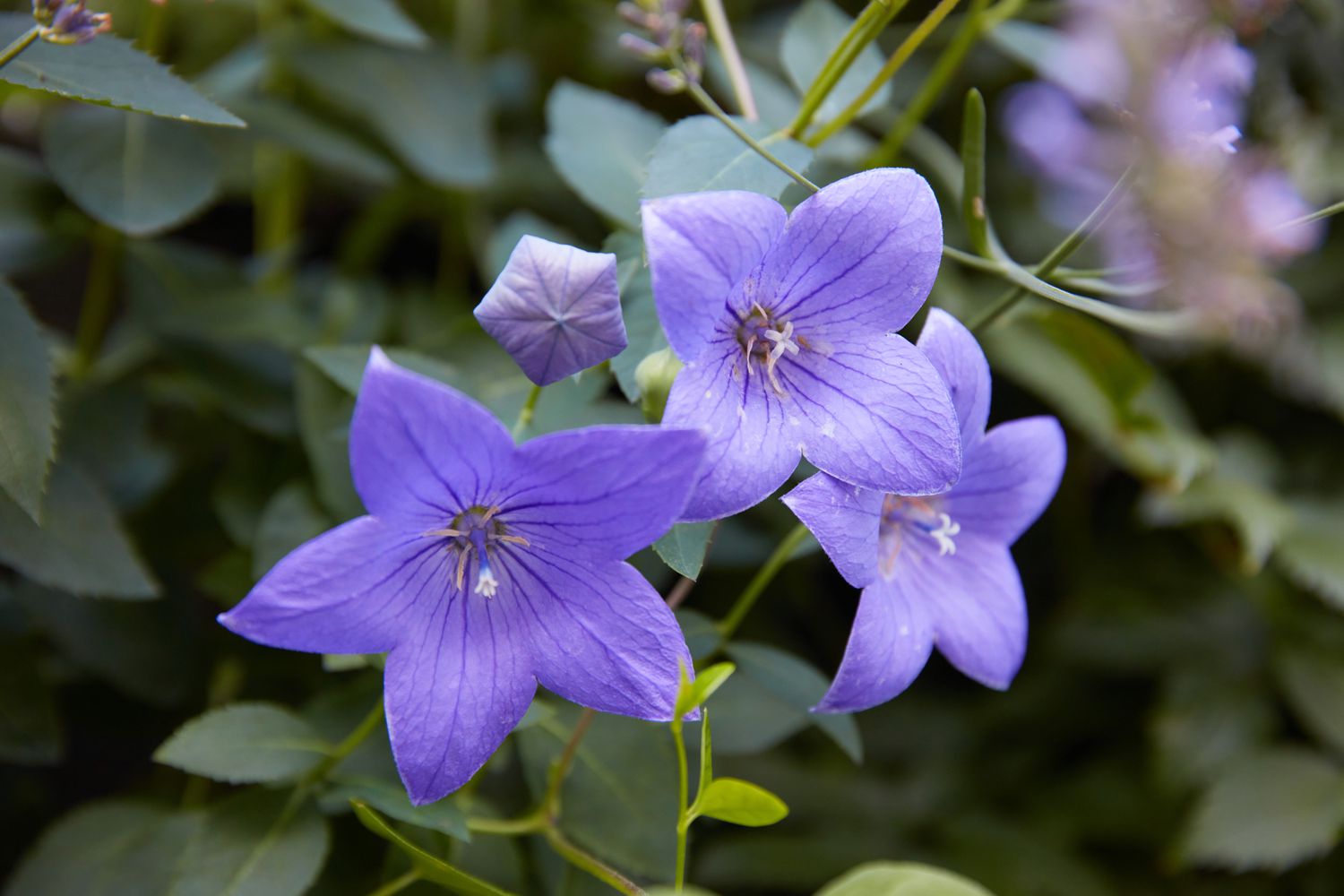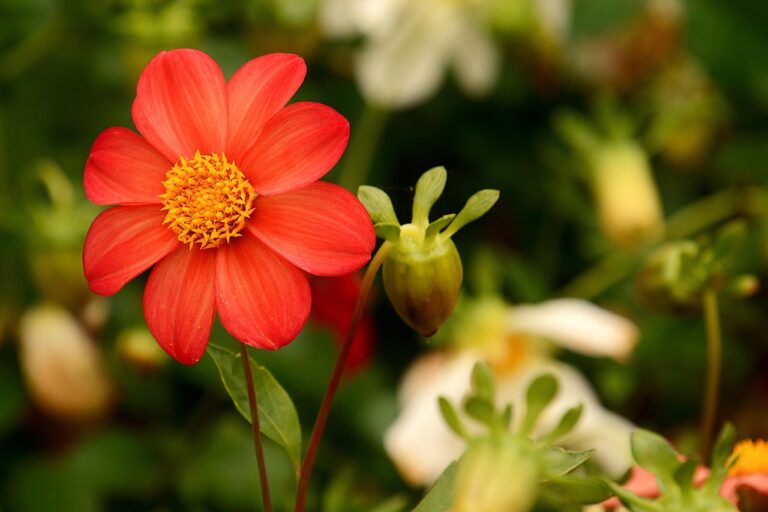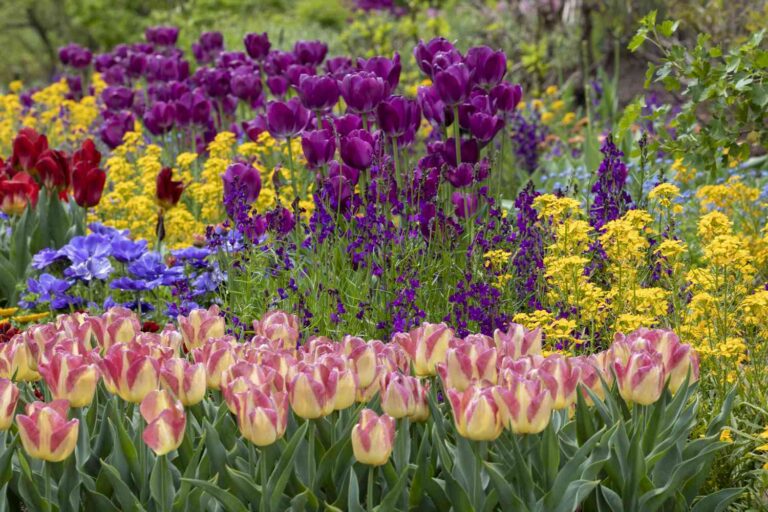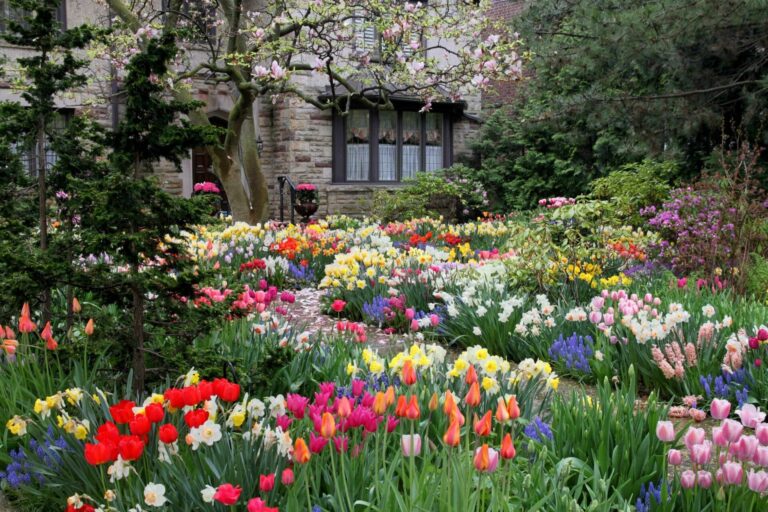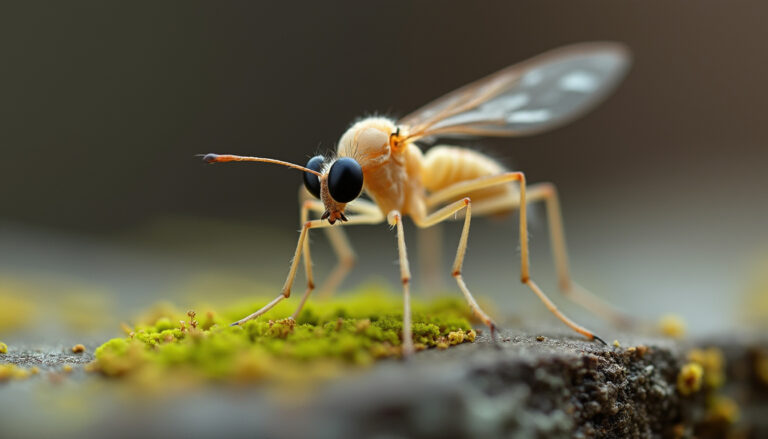6 Best Late Flowering Plants for Fall Gardens | Extend Blooms
Experienced gardeners recognize that summer’s active season transitions into autumn’s unique seasonal conclusion. The late-season garden provides an excellent chance to enjoy your outdoor space through September and into the first frost because numerous perennials maintain their blooms until the first frost. The autumn champions serve as essential nectar sources for pollinators who need them during their winter preparation time while adding visual appeal to the landscape as other plants fade away.
Your garden becomes a four-season paradise through the strategic placement of late-flowering plants which continue to bring color and life to your outdoor spaces during Halloween decoration season and holiday planning. The success of your fall garden depends on selecting suitable varieties for your climate conditions and proper care methods during the long blooming season and scheduled maintenance activities.
“The autumn garden provides an exceptional opportunity to extend the growing season with strategic plant selection that supports both aesthetic appeal and essential wildlife habitat.”
1. Japanese Anemone: The Romantic Fall Dancer
Scientific Name: Anemone hupehensis var. japonica
The flowers bloom from August through October and continue to bloom until the first frost of winter.
Japanese anemones claim their position as the top autumn garden flowers because their delicate flowers appear to float on slender stems which grow between 2 to 4 feet tall. These advanced perennial flowers start their display during late summer when most other plants rest for winter by producing delicate petals in pale pink and white and deep rose colors which glow in the autumn sunlight.
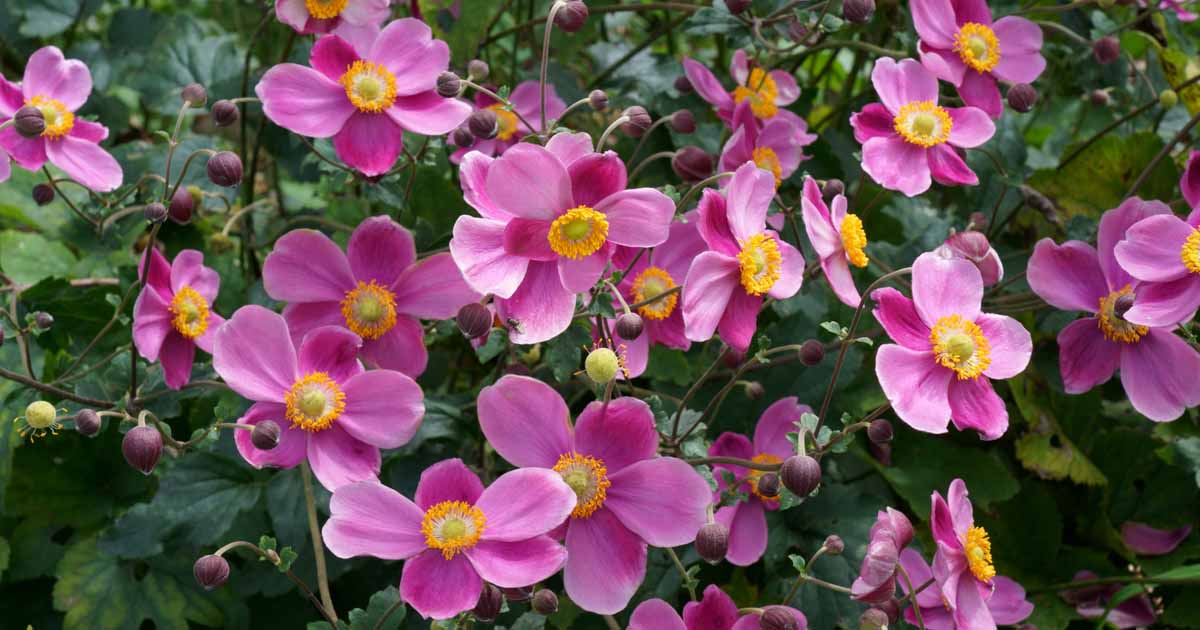
Japanese anemones have developed intricate plant characteristics through natural evolutionary development which enables them to extend their growing period. The flowers of this plant produce single or double blooms which measure 2 to 4 inches in diameter and contain large golden centers that serve as food sources for late-season butterflies and honeybees and beneficial insects. The plants grow through underground rhizomes at a moderate rate which forms elegant colonies that dance in autumn winds to bring motion to stationary garden arrangements.
Growing Requirements
The woodland native plants require partial shade to filtered sunlight to grow well because they excel in areas beneath deciduous trees after spring bulb displays. The plants need protection from hot afternoon sun in warmer areas to stop their flowers from fading too quickly. The combination of well-draining soil with organic matter leads to healthy plant growth but established plants become drought-resistant after their deep root systems mature.
The seeds need 18 to 24 inches of space when planted in spring for their natural development. Position them in areas where their winter stems will not obstruct views because they will completely disappear into the ground after frost. The key to successful establishment lies in consistent moisture during their first growing season, after which they become surprisingly low-maintenance performers.
Care and Maintenance
The plants need deep watering during dry spells which should happen when they are new or when they produce buds in late summer. Use a light amount of organic fertilizer during early spring but select products with balanced nutrients since high-nitrogen formulas lead to leafy growth that reduces blooming potential. Deadheading spent flowers extends the blooming period, though many gardeners appreciate the decorative seed heads that provide winter interest.
Japanese anemones function well as standalone plants in mixed borders because they use their vertical growth to stand out among sedum and ornamental grasses. The delicate texture of these plants pairs well with strong hostas and ferns and their flowing shape creates a romantic look that works with modern garden structures. The plants should be placed along walking paths to showcase their small flowers and under tree cover for their ability to spread and create naturalized displays.
2. Autumn Joy Sedum: The Four-Season Champion
The scientific name for this plant is Hylotelephium ‘Herbstfreude’ which used to be known as Sedum ‘Autumn Joy’.
The plant produces seed heads from August until November while these seed heads stay present throughout winter months.

Autumn Joy sedum stands as a perfect example of year-round garden interest because this succulent perennial plant displays multiple seasons of beauty with low maintenance needs. This architectural powerhouse begins its display in spring with blue-green, fleshy foliage that forms perfect mounds 18 to 24 inches tall and wide. The plants create textural contrast with their coarse leaves against their delicate-leaved neighbors during summer months but they reach their peak beauty in late summer.
Seasonal Color Display
The broccoli-green flower heads of August will turn into pink shades before reaching their final deep bronze color as autumn temperatures set in. The flower heads display a spectacular color transformation which follows the seasons of autumn while their honey-like scent draws beneficial insects including butterflies and honeybees and predatory wasps that help manage garden pests.
“Autumn Joy sedum provides continuous seasonal interest with its remarkable color evolution from summer green to autumn bronze, making it an indispensable four-season garden performer.”
Sedums possess drought tolerance because their thick leaves and stems function as water storage containers which allows them to survive dry conditions after their initial establishment. The adaptation reaches its highest point during late summer because plants need ongoing water supply for blooming yet rainfall becomes limited at this period. The plants have shallow fibrous roots which help to stop soil erosion and their succulent leaves protect them from deer and rabbit feeding.
Growing Conditions
The plant requires full sun exposure to achieve its most vibrant flower colors and develop strong stems that will not fall over. Soil needs proper drainage so heavy clay soils require addition of coarse sand or fine gravel for better drainage. These plants succeed in poor rocky soil conditions which makes them perfect for difficult locations such as slopes and rock gardens and hot spots near walls and pavement.
Propagation and Care
Autumn Joy sedum reproduces through division during spring and fall because the new divisions develop into full flowering plants at a fast rate. Stem cuttings obtained in summer’s beginning months successfully root in draining soil mix which makes it possible to propagate plants at a low cost on a big scale. When planting, avoid burying the crown too deeply, as this can lead to stem rot in wet conditions.
The Seasonal Care Calendar requires gardeners to cut back plants to 4 to 6 inches during early spring before new growth appears while keeping seed heads for wildlife food and winter beauty. The application of balanced fertilizer during springtime promotes healthy plant development but excessive application leads to excessive growth that may cause the plant to fall over. The late May pinch of stem tips will help create bushier growth while pushing back the flowering time to achieve longer blooming.
Mass plantings create long-range seasonal views for public viewing but single plants serve as decorative elements in different border arrangements. The plants’ drought tolerance makes them useful for water-efficient gardens while their ability to grow in poor soil makes them suitable for urban areas with degraded soil quality.
3. New England Aster: The Pollinator Magnet
Scientific Name: Symphyotrichum novae-angliae
The plant blooms from September to October but certain varieties extend their blooming period into November.
Native asters serve as a vital addition to North American fall gardens because they offer crucial nectar and pollen resources during the time when most other food sources have disappeared. The New England asters create a beautiful display through their 1 to 2 inch daisy-like flowers which feature purple petals that frame golden yellow centers that shine against autumn’s subdued tones.
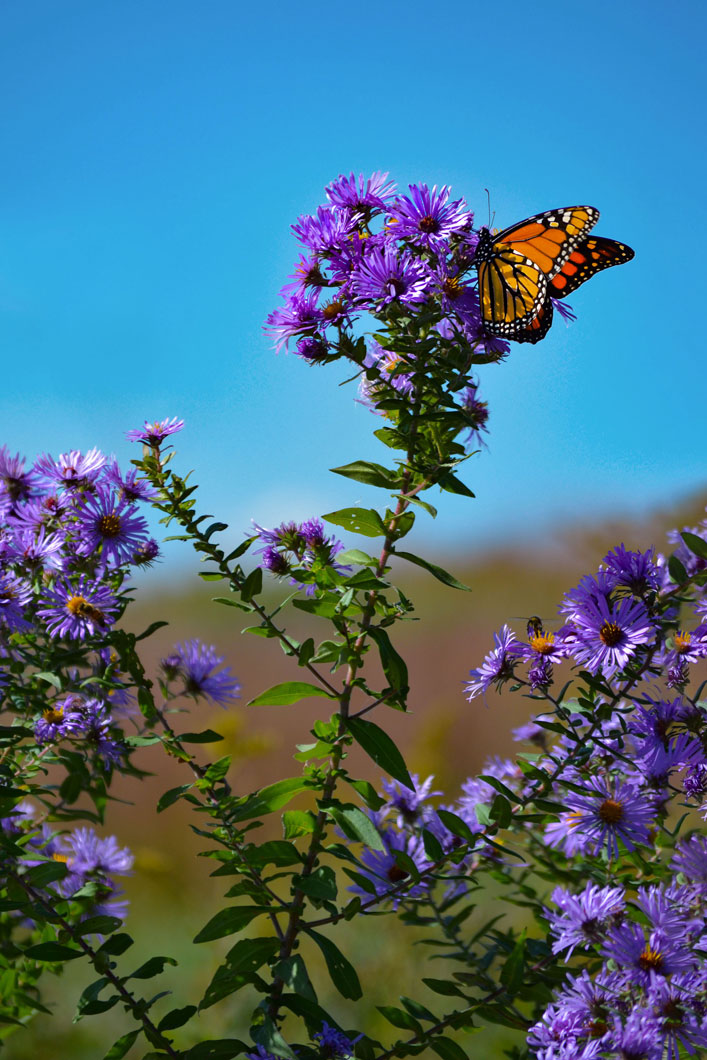
Ecological Importance
The plants play a vital role in maintaining the natural environment. Native plant societies together with extension services perform research which shows asters rank as the number one pollinator-friendly perennial because they support more than 100 butterfly and moth species and numerous native bee populations. The plants bloom at the end of summer which matches the time monarch butterflies migrate to Mexico so they can provide essential energy for these incredible travelers.
“New England asters support over 100 species of butterflies and moths, making them the top choice for pollinator-friendly fall gardens and essential fuel stations for migrating monarchs.”
Varieties and Characteristics
Modern breeding programs now offer a wider range of colors than traditional purple through their development of deep rose and vibrant magenta and soft pink and pure white varieties. Plant sizes span from 12-inch compact varieties suitable for containers and front borders to 4-foot tall specimens which make striking back border displays. ‘Purple Dome’ is a well-known compact variety that grows to 18 inches with deep purple flowers and ‘Alma Potschke’ produces 3-foot tall plants with rose-pink flowers.
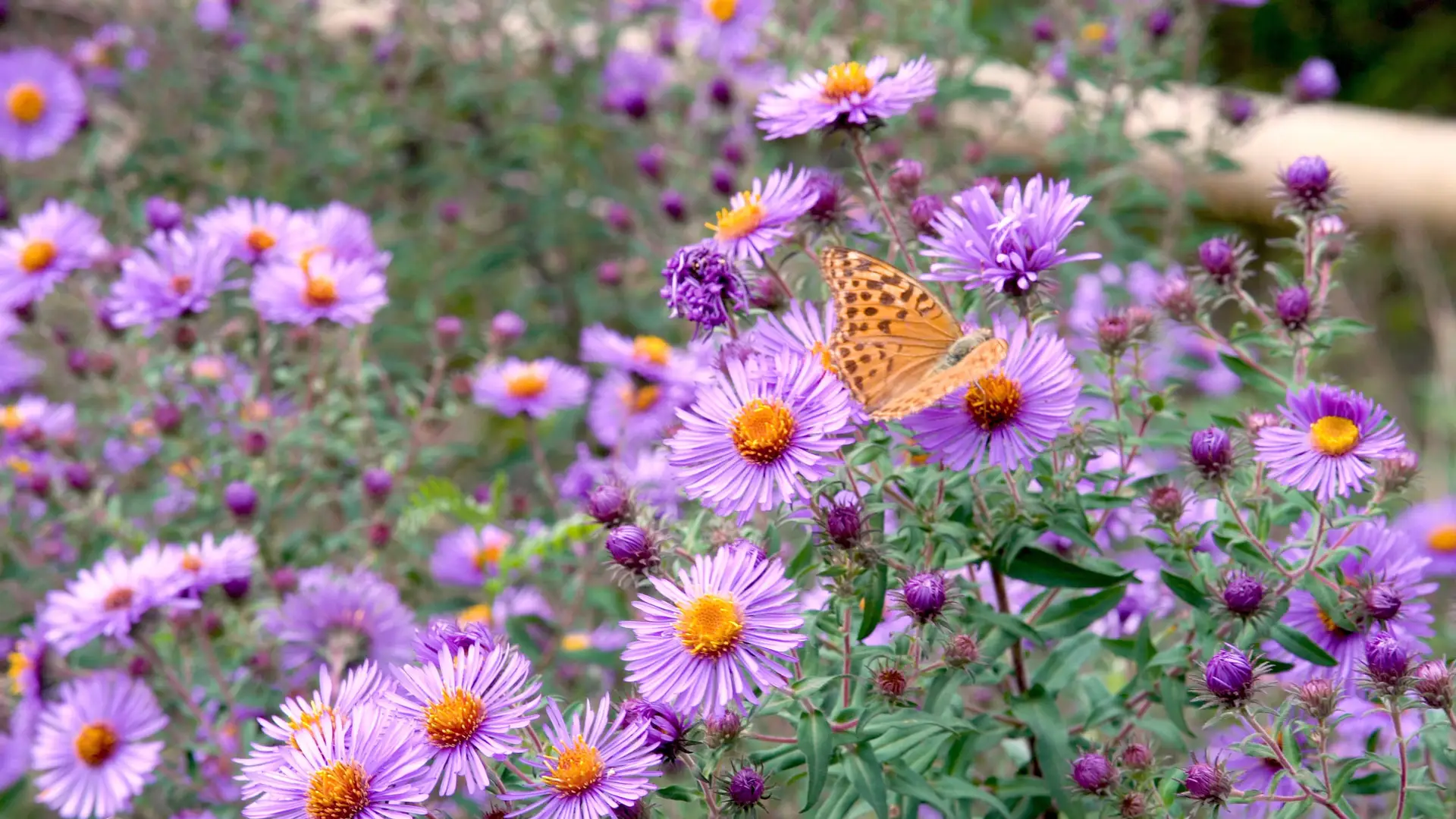
Growing Requirements
The plants require full sun exposure to produce their maximum number of flowers and develop strong stems but they can handle light shade during hot afternoons in warm weather conditions. The right soil type with high water retention capabilities leads to the best results but plants that have already established themselves can survive dry conditions. Good air circulation acts as a preventive measure against powdery mildew which frequently affects plants in humid environments with limited air circulation between dense plant groups.
Maintenance Techniques
The maintenance process requires stem tip pinching during early summer (July 4th in northern regions) to develop bushy growth and stop plant flopping and increase flower production. The basic method of pinching flowers creates a time delay in blooming which results in longer blooming seasons for gardens that include both pinched and unpinched plants.
Cut plants back to ground level after frost kills the foliage, removing disease-prone debris that could harbor overwintering pathogens. The process of dividing plants every three to four years helps both to refresh overgrown clumps and to create additional plants for garden growth and distribution. The best time to divide plants depends on the climate because spring works well in cold areas yet fall works best in areas with gentle winters. Seed collection needs patience because seeds require 30 to 60 days of cold stratification to achieve optimal germination rates which replicates the natural winter process.
4. Goldenrod: The Native Showstopper
Scientific Name: Solidago species
Bloom Period: August through October, depending on species and climate
The bright yellow plumes of Goldenrod have become a symbol of autumn in many parts of North America yet this native plant family continues to confuse gardeners who believe it causes seasonal allergies. The truth reveals goldenrod as an innocent party in the hay fever blame game; its heavy, sticky pollen requires insect transportation rather than wind distribution. Ragweed, which blooms simultaneously but inconspicuously with green flowers, actually causes the allergic reactions commonly attributed to its showy neighbor.
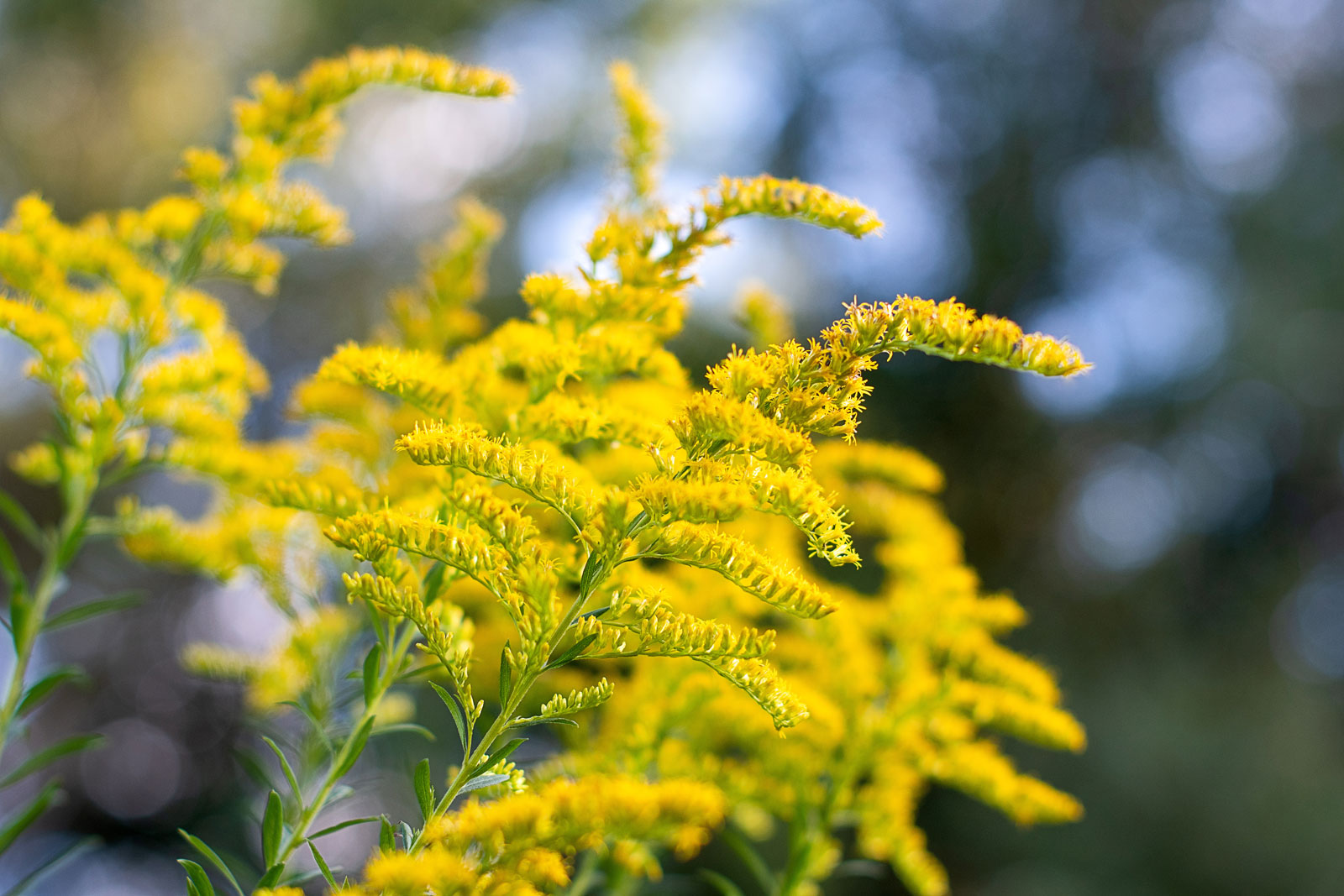
Species Diversity and Garden Options
The Solidago genus contains more than 100 different species which span from small 6-inch alpine plants to large 6-foot tall meadow plants that match various garden needs. The architectural flower plumes made up of hundreds of small blooms function as vertical decorative elements that match the curved shapes of neighboring plants and serve as a food source for beneficial insects during the late season.
Native plant species Goldenrod hold the highest ecological value because they serve as essential support for native ecosystems. University extension research indicates that individual plants can support over 100 species of butterflies and moths, plus countless native bee species including specialist bees that evolved exclusively with goldenrod flowers. The flowers bloom at the exact time monarch butterflies migrate through the area which makes them vital elements for butterfly gardens that aim to support these incredible insects.
:max_bytes(150000):strip_icc()/goldenrod-wildflowers-2132951-02-c9a30d34b1a9449a90766d98c199ac42.jpg)
Cultivar Recommendations
The residential garden option ‘Fireworks’ (Solidago rugosa) presents itself as a better choice because it grows 2 to 3 feet tall with elegant curved stems that produce golden plumes that evoke the appearance of fireworks. This cultivar demonstrates superior garden manners compared to the species, spreading less aggressively while maintaining all the ecological benefits. ‘Golden Fleece’ (Solidago sphacelata) creates tight clusters of flowers on its short-growing habit which reaches 12 to 18 inches tall and works well in front-of-border and rock garden arrangements.
Growing Conditions and Management
The majority of goldenrod species require full sun exposure yet some species adapt to partial shade conditions when sunlight becomes too intense during hot afternoons. The specific soil needs of each plant species require well-draining soil with average fertility levels. The drought tolerance of established plants makes them suitable for water-wise landscapes and difficult growing areas.
“Choose clump-forming goldenrod species or named cultivars to enjoy spectacular fall color and wildlife support without the aggressive spreading behavior of some wild varieties.”
The invasive nature of Canada goldenrod (Solidago canadensis) and other species becomes a concern because they use underground rhizomes to spread aggressively which makes them difficult to control in structured garden environments. Choose clump-forming species or named cultivars which have proven non-invasive behavior for creating mixed perennial borders. The practice of removing spent flowers before seed development helps manage plant dispersal and lengthens blooming time because it directs plant resources toward making more flowers instead of seeds.
5. Monkshood: The Mysterious Late Bloomer
Scientific Name: Aconitum napellus
Bloom Period: July through September, often continuing into October in cooler climates
Monkshood stands out as a dramatic fall garden addition because it displays showy spire-shaped helmet-like flowers which create a theatrical appearance. The 1 to 2 inch wide deep blue-violet flowers grow on strong stems that can extend up to 4 feet tall to create vertical visual interest in mixed border plantings. The plant’s distinctive flower design which looks like medieval helmets or hooded robes leads to its common name and mystical standing in society.
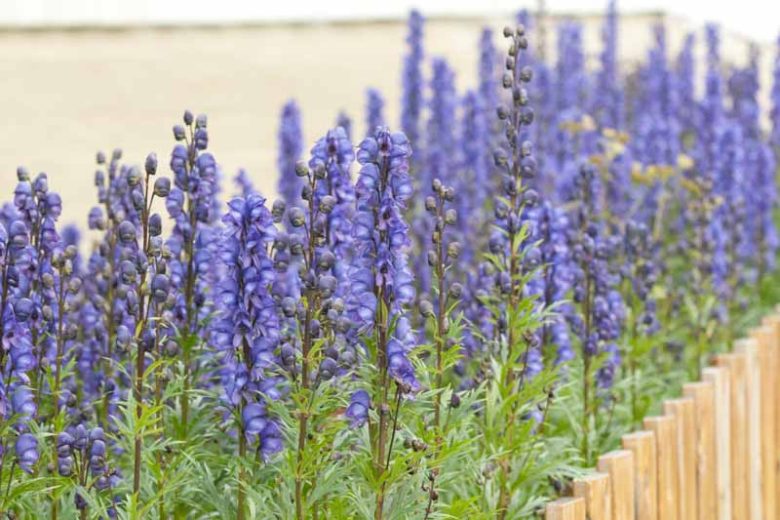
Important Safety Considerations
The striking beauty of monkshood comes with an important caveat that every gardener must understand: all parts of the plant contain potent alkaloids that can be toxic if ingested or absorbed through broken skin. This characteristic has earned monkshood historical names including “wolfsbane” and “queen of poisons,” as extracts were traditionally used for hunting and other purposes. Modern gardeners should handle these plants with care but proper education and safety measures enable them to grow them safely.
“Plant monkshood in areas where children and pets don’t play, and always wear gloves when handling any part of the plant to safely enjoy its dramatic fall beauty.”
Toxicity Management in Gardens: Plant monkshood in areas where children and pets don’t play, and always wear gloves when handling any part of the plant. These plants present their main danger through ingestion rather than through typical human contact so they can be safely used in areas where people can monitor them. The unique flower design makes it difficult for children to mistake the plant for food because they tend to stay away from plants with strange looks. Placing monkshood at the back of borders allows its tall stature to become an attractive feature that deters intruders from reaching the flowers.
Growing Requirements
Monkshood requires partial shade as its ideal growing condition because it needs protection from hot summer sun to thrive. The plants need rich moist soil to thrive but they can survive short periods of dryness. These woodland natives appreciate the cooling effects of organic mulch and benefit from protection from strong winds that can damage their tall flower spikes.

Propagation and Care
The plant needs division every four to five years during early spring for both propagation and care purposes but handling it demands protective equipment because of its toxic nature. Seed propagation works but it needs time because seeds need 30 to 90 days to germinate under perfect growing conditions. Young plants need staking as protection from wind until their root systems develop completely.
Garden Design Applications
Monkshood functions best as a specimen plant because it allows people to see its distinctive flowers in detail and also works well when planted in big groups to create a dramatic landscape effect. The vertical shape of these plants creates an excellent visual contrast with rounded plants like hostas and coral bells while their autumn bloom time connects the end of summer to the beginning of fall. Consider planting them near seating areas where their unusual flowers invite closer inspection, though always with appropriate safety education for all garden users.
6. Toad Lily: The Shade Garden’s Autumn Surprise
Scientific Name: Tricyrtis species
The blooming period of this plant occurs between August and October before the arrival of winter frost.
Gardeners who experience either blessing or curse from excessive shade face an especially difficult search for perennials that bloom during autumn. The toad lily represents an Asian native plant which succeeds in deep shade conditions to create unique autumn flowers. These shade-dwelling specialists prove that lack of sunlight need not limit your fall display options.
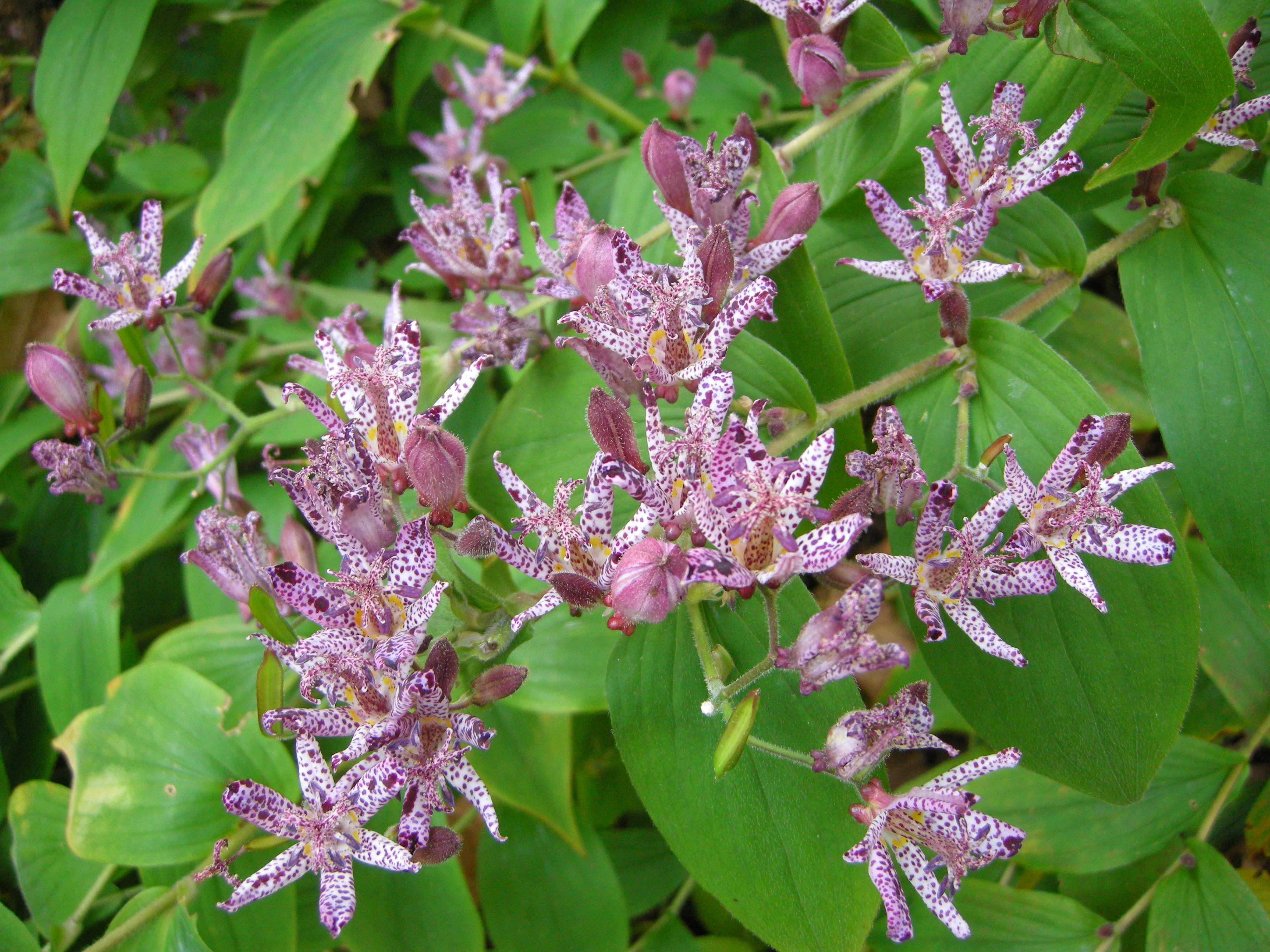
Unique Flower Characteristics
The flowers of toad lilies appear almost alien in their complexity, bearing spotted or speckled petals that create an orchid-like appearance completely unexpected in shadier garden areas. The flowers reach about 1 inch in diameter with six star-shaped petals that display skin-like spots which give them their common name. The color scheme consists of white backgrounds with purple spots and pale yellow with brown speckles and deep purple with lighter markings which produce complex designs that need detailed inspection.
Evolutionary Adaptations
The Toad lily has evolved particular survival mechanisms which enable it to thrive in low-light conditions that other flowering plants cannot tolerate. The plants achieve maximum light absorption through their wide flat leaves which operate well in low light environments and they produce flowers at the end of the season when trees have lost their leaves and sunlight becomes more accessible. This evolutionary timing allows them to photosynthesize and produce flowers when competition for light resources decreases significantly.
:strip_icc()/toad-lily-585d3d28-213f54c0e36a424eb15b4e86483b5710.jpg)
Growing Requirements
The main requirement for toad lily cultivation success depends on maintaining consistent moisture levels because these plants developed in Asian woodland environments with high humidity. The soil needs to stay consistently moist but should never become waterlogged because root rot develops in wet conditions. The native forest floor habitat of these plants matches the characteristics of rich organic soil yet established plants thrive in typical garden soil with sufficient organic matter.
Species and Varietal Options
The Japanese toad lily (Tricyrtis hirta) stands as the most accessible species which grows 2 to 3 feet tall with white flowers that display purple spots. The Formosa toad lily (Tricyrtis formosana) displays bigger flowers with darker purple tones while ‘Dark Beauty’ shows black flowers with yellow patterns that produce striking visual effects in shaded environments.
Propagation Methods
The most reliable method for propagating this plant happens through division in early spring because established clumps can be divided into smaller sections that quickly establish themselves. Stem cuttings require moist well-draining medium for successful rooting during early summer months but the process demands patience because root development occurs at a slow rate. Seed propagation works but it needs exact temperature stratification and requires two to three years to produce flowering-size plants.
Design Combinations
The arrangement of Toad lilies with other shade-tolerant plants produces an attractive display because of their contrasting plant structures and textures. Their vertical growth habit works well with low-growing groundcovers such as vinca and pachysandra and their exotic flowers match other Asian woodland natives including Japanese painted ferns and hostas with variegated foliage. The same planting area can support early spring bulbs since they finish their life cycle before toad lilies start their annual display.
Advanced Methods for Maximum Late-Season Flower Display
The creation of a fall garden which stays attractive from late August until holiday time needs careful planning and tested methods to protect plants and preserve garden aesthetics. The most successful autumn gardens succeed through strategic plant choices and proper cultural methods which enhance blooming results while protecting plants during the difficult time between active growth and winter rest.
:strip_icc()/bhg-sneezeweed-helenium-101998877-43a7ba946f8a475d8f6ff76b8a214c5c.jpg)
Deadheading for Extended Blooms
The simplest method to extend plant blooming duration involves deadheading spent flowers because it redirects energy from seed production toward producing more flowers. The method works best for asters and goldenrod and Japanese anemones since these plants produce additional blooms that extend through the winter months until frost sets in. The process of deadheading depends on timing because it should happen when flowers start to fade but before seeds develop because seed production drains plant energy.
Succession Planting Techniques
The practice of planting different varieties at different times throughout the season will produce a natural sequence of blooming flowers through Succession Planting Techniques. The method proves most effective for annual plants that grow quickly such as cosmos and zinnias because it allows direct seeding during summer months. Choose perennial varieties that have different bloom periods within the same species including early and mid-season and late-blooming aster cultivars.
Microclimate Management
Plants that are placed in specific microclimates will remain in bloom for longer because they get protection from frost and experience consistent temperatures. The south-facing walls and fences of a garden absorb daytime heat which they then release into the environment during the night thus creating areas with warmer temperatures that protect plants from frost damage. Placing sensitive plants under deciduous tree canopies protects them from frost while providing sufficient sunlight when leaves fall off.
“Strategic microclimate management can extend blooming periods by several weeks, allowing gardeners to enjoy fall flowers well into the holiday season.”
Soil and Nutrition Management
Soil and Nutrition Management: The process of late-season blooming depends on plant energy reserves which need proper nutrition to maintain performance. However, timing fertilizer applications correctly prevents tender new growth that might be damaged by early frost. Apply a balanced slow-release fertilizer during early summer to provide ongoing nutrition throughout the extended growing period by selecting products with low nitrogen content which helps control leaf growth from surpassing flower development.
Water Management Strategies
The management of water stress needs to maintain steady moisture levels during late-blooming perennials’ bud formation and blooming stages to get the highest flower output and extended blooming duration. Plants develop stronger root systems when watered deeply but infrequently because this method allows them to survive dry spells and continue producing flowers.
Container Gardening Solutions
Container gardening serves as a perfect solution for areas where plants cannot thrive because different plants require specific growing environments. Large containers give gardeners complete control of soil mix and drainage and microclimate conditions while allowing them to arrange plants for the best visual effect. The method works best for Japanese anemones since these plants tend to spread uncontrollably in garden beds yet stay under control when planted in containers.
Conclusion: Creating Your Four-Season Paradise
The late-season gardens play vital ecological roles which extend past human recreation because they offer vital resources for pollinators to survive winter and seed-eating birds to find food during their most challenging times. The combination of wildlife requirements with garden planning produces two advantages which support environmental worth and gardening success through continuous plant reproduction and organic pest control.
A spectacular late-season garden requires investment for year-round outdoor use which generates benefits throughout the autumn season. The combination of proper plant selection and established cultural practices and knowledge about fall-blooming perennial requirements enables gardeners to develop outdoor spaces that display color and ecological value during the longer post-traditional gardening period. The autumn champions show that gardening produces autumn displays which match springtime beauty while supporting wildlife through winter season.
“A well-designed fall garden with late-flowering plants creates a four-season paradise that supports both human enjoyment and essential wildlife habitat through the challenging autumn transition period.”
For more information on fall gardening techniques, visit the University Extension Service or explore native plant resources through the National Wildlife Federation. Learn about pollinator-friendly gardening practices at Pollinator Partnership and discover additional native plant options through your local Wild Ones chapter.

